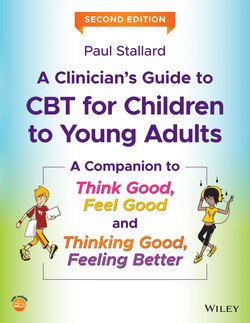Читать книгу A Clinician's Guide to CBT for Children to Young Adults - Paul Stallard - Страница 17
Technologically delivered CBT
ОглавлениеThere is increased interest in the use of technology to support and deliver CBT to children and adolescents. Technology offers the potential to reach geographically isolated populations; flexible access; increased convenience; fewer visits to specialist clinics; greater privacy and anonymity; enhanced treatment fidelity; rapid scalability; and low‐cost delivery (Clarke et al. 2015; MacDonell & Prinz 2017). It is also very acceptable and particularly appealing to adolescents, who are typically early adopters and regular users of new technologies (Johnson et al. 2015; Wozney et al. 2018).
Internet or technologically delivered CBT programmes have attracted much interest and have demonstrated encouraging results (Grist el al. 2019; Pennant et al. 2015; Vigerland et al. 2016). Digital technologies deliver interventions via computers, or through web‐based platforms via mobile tablets or smartphones (Hollis et al. 2017). The structured nature of CBT lends itself well to digital delivery, resulting in several computerised CBT interventions being developed. For example, the face‐to‐face CBT anxiety programme Cool Teens can be effective when delivered via a CD‐ROM with minimal therapist support (Wuthrich et al. 2012). Similarly, online CBT anxiety programmes such as BRAVE were found to be very acceptable to young people and as effective as face‐to‐face CBT (Spence et al. 2011). In terms of depression, encouraging results have been reported for Stressbusters, a computerised CBT program (Smith et al. 2015; Wright et al. 2017) and a computer game (SPARX) when used both as an intervention and as a prevention programme (Merry, Hetrick, et al. 2012; Merry, Stasiak, et al. 2012; Perry et al. 2017).
Reviews indicate that technologically delivered CBT is effective (Grist et al. 2019) and is now recommended in the United Kingdom as a first line treatment for mild to moderate depression (NICE 2019). Other technologies such as apps, virtual reality, and games have seldom been developed or evaluated.
